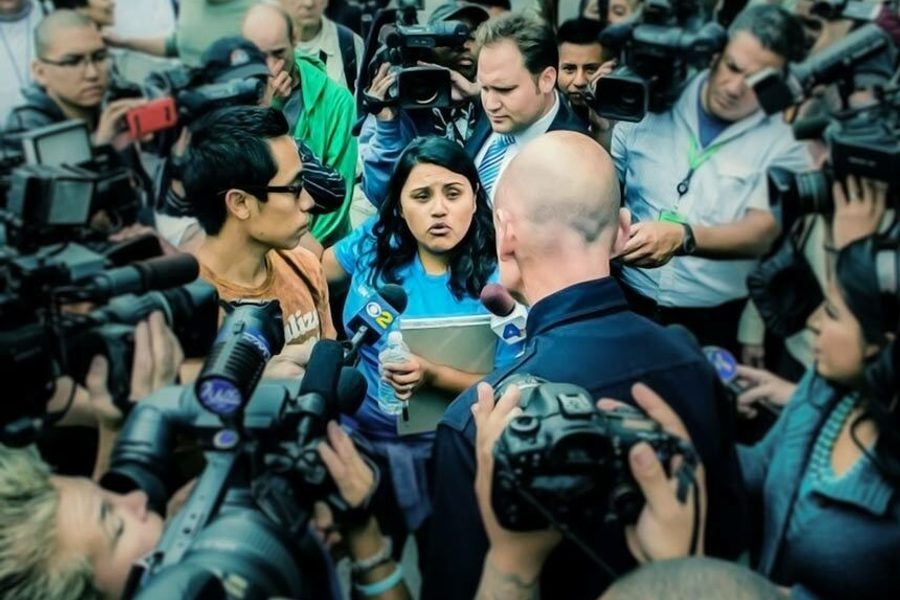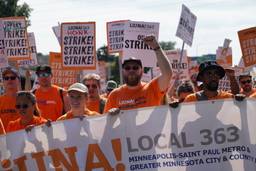Attacks on Immigrants Are Attacks on Workers
A longtime labor and community organizer responds to the Trump’s anti-immigrant measures.
Carlos Ballesteros

Less than a week into his presidency, Donald Trump acted on some of his most extreme campaign promises. On January 25, Trump signed a set of executive orders that will add 10,000 more agents to the already bloated Immigration and Customs Enforcement (ICE), allow local law enforcement officers to detain and arrest undocumented immigrants, block federal funds to sanctuary cities and commence construction of a wall along the U.S.-Mexico border. In other words, Trump started by doing exactly what he said he would — and he’s hardly slowed down since.
While the situation is bleak, Neidi Dominguez believes that Trump’s agenda can be defeated. A long-time grassroots organizer and current director of worker center and community engagement for the AFL-CIO, Dominguez is at the forefront of a growing alliance between the labor and immigrant rights movements. She was instrumental in the union-backed campaign that mobilized thousands of voters in Maricopa County, Ariz., last fall to oust xenophobic Sheriff Joe Arpaio, who subjected immigrants to the kind of racial profiling and arbitrary detention that the president is now promising to enact nationwide.
Born in Cuernavaca, capital of the Mexican state of Morelos and a historic hotbed of leftist organizing, Dominguez migrated to the U.S. at age 9. After graduating in 2008 from the University of California, Santa Cruz, where she co-founded a support group for undocumented students, Dominguez helped spearhead organizing that led to the Deferred Action for Childhood Arrivals (DACA) presidential executive order in 2011. Dominguez has continued to organize immigrant communities since, particularly at the workplace. In These Times spoke with her about Trump’s anti-immigrant executive orders.
The first week of Trump’s presidency was challenging, to say the least. How did you react to his immigration orders?
It was a very hard day. A huge blow. At the same time, it was extremely powerful to see people’s reactions. Here in D.C., there were multiple actions. Our local labor council came out and took over the streets, and we had a rally right in front of the White House. So I’ve been feeling both sick to my stomach and also really ready to fight.
Were you at all surprised by the news?
Trump ran his campaign on the backs of people like myself and my family, who are Mexican and undocumented immigrants. I wasn’t necessarily surprised or shocked by his win, but I was still very sad and angry. I’ve lived in this country most of my life, and still I’m never going to be fully accepted. I don’t believe Trump represents how the majority of the country feels. But I still wondered, “How did we get here?”
One of the few bright spots of the November elections was the successful campaign to oust Sheriff Arpaio. What lessons can you draw from the Bazta Arpaio campaign?
It was empowering to see the community that had been terrorized by Arpaio take him out once and for all. We successfully engaged 10 different unions, including the American Federation of Government Employees (AFGE), a union that represents Border Patrol, to be part of this campaign to mobilize Latino voters and kick out Arpaio.
We really attempted to get more sophisticated around the question of what kind of infrastructure, data and support we needed to mobilize people of color beyond the presidential election. We can’t just be talking to people once every four years. The doors that we knocked on were those of Latino voters who only voted once in the last four years, making them only 30 percent likely to vote. Those were voters that neither party was reaching. But we felt that we needed to talk to them because if we don’t, who will? All Latinos are not the same, and people are going to move based on issues, not candidates.
Arpaio’s policies are a stark example of how undocumented immigrants are criminalized. But more liberal policies, including those in many sanctuary cities and President Obama’s Deferred Action for Childhood Arrivals (DACA) program, don’t protect “criminal” immigrants. Many people don’t realize that undocumented immigrants can be charged for crossing the border, and are often more likely to be profiled and stopped for traffic violations. What’s the effect of this rhetoric that divides immigrants into the “good” and the “bad”?
Having been part of the DACA movement, I learned that we create the strongest shield when we fight for everyone, including those, for example, with DUIs. Many people are going to have something in their history that happened years ago.
In the past, there’s a threat we’ve seen — even with the DREAM Act— that when a bill has a very small benefit for a very specific group of people, lawmakers will often attach even harsher enforcement measures for everyone else to it. We need to have a much more complex conversation about immigration. Further criminalizing immigrants in this country is not the answer.
Organizers are calling on schools, universities and places of worship to provide sanctuary for all immigrants facing deportation. Do you see this as a way forward?
Yes, but we need to both defend and expand the meaning of “sanctuary.” We can’t just have sanctuary cities for immigrants. It has to be a sanctuary city for everyone — people of color, Muslims, immigrants, refugees, women and the LGBTQ community.
How have your own experiences as an immigrant shaped your politics?
A year after I came to the United States, California passed Proposition 227, which got rid of bilingual education in public schools. I didn’t know any English and I was put into this English-only class. That first year was horrible, very traumatizing for a 9-year-old. That shaped my understanding of my place in this country as an immigrant, that I was undocumented and what that meant.
As a kid, my mom got active with the Institute of Popular Education of Southern California, which was organizing immigrant families and workers. So at 10, I was out there at protests, talking about how we need to have safe spaces for workers who were being persecuted by the local police.
What role should the labor movement play in supporting immigrants?
I grew up in a household where my mother was a domestic worker and organizer. My entry point into this movement was the intersection of workers’ rights and immigration. So for me, labor being engaged and fully at the forefront of the immigrant rights fight in this country is not just out of solidarity. Those are our members. We have millions of immigrant workers in our unions. And immigrant workers are what make this country run every day, regardless of whether they have a union contract or not.
What do you think the workplace will look like for immigrants under a Trump presidency?
We expect to see more workplace raids. Immigration enforcement is also a clear attack on unions. Employers might decide to “self-audit” and call up ICE to raid a shop that is organizing. That could literally kill a whole union campaign. Where there’s already a union contract, employers might use the same tactic in the middle of renegotiating that contract to basically kill the union.
We see workplace raids as very anti-worker, anti-union tactics. The more we have to respond to workplace raids instead of servicing and growing our union, the more the union is under threat.
What does solidarity look like in this moment?
Right now, we’re getting our members ready to defend their unions against the raids. Given the speed of these attacks, we are going to have to create something new. It’s time for us all to fight together. There are already attacks on immigrants and Muslims and refugees, but more are on their way. We know what Trump’s agenda is. Let’s not just wait until those things hit. We need to keep our eyes on the prize.








